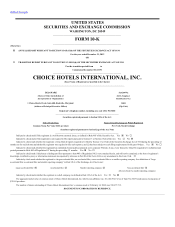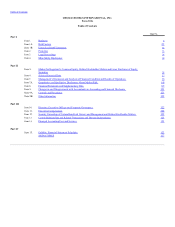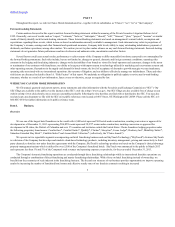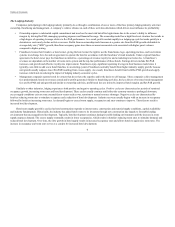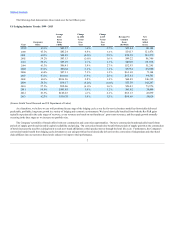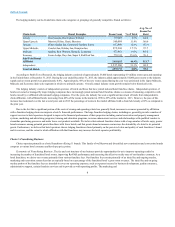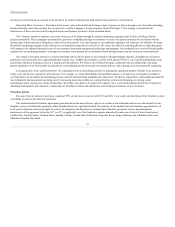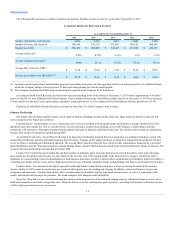Comfort Inn 2013 Annual Report Download - page 5
Download and view the complete annual report
Please find page 5 of the 2013 Comfort Inn annual report below. You can navigate through the pages in the report by either clicking on the pages listed below, or by using the keyword search tool below to find specific information within the annual report.
Table of Contents
initial and relicensing fee revenue, ongoing royalty fees and procurement services revenues. In addition to these revenues, we also collect marketing and
reservation system fees to provide support activities for the franchise system. Our operating results can also be improved through our company-wide efforts
related to improving property level performance. The Company's hotel franchising business currently has relatively low capital expenditure requirements.
The principal factors that affect the Company’s results are: the number and mix of franchised hotel rooms in the various hotel lodging price categories;
growth in the number of hotel rooms under franchise; occupancy and room rates achieved by the hotels under franchise; the effective royalty rate achieved; the
level of franchise sales and relicensing activity; and our ability to manage costs. The number of rooms at franchised properties and occupancy and room rates
at those properties significantly affect the Company’s results because our fees are based upon room revenues or the number of rooms at franchised hotels. The
key industry standard for measuring hotel-operating performance is revenue per available room ("RevPAR"), which is calculated by multiplying the percentage
of occupied rooms by the average daily room rate realized. Our variable overhead costs associated with franchise system growth of our established brands
have historically been less than incremental royalty fees generated from new franchises. Accordingly, continued growth of our franchise business should
enable us to realize benefits from the operating leverage in place and improve operating results.
We are contractually required by our franchise agreements to use the marketing and reservation system fees we collect for system-wide support activities.
These expenditures help to enhance awareness and increase consumer preference for our brands. Greater awareness and preference promotes long-term growth
in business delivery to our franchisees and increases the desirability of our brands to hotel owners and developers, which ultimately increases franchise fees
earned by the Company.
Our Company articulates its mission as a commitment to our franchisees’ profitability by providing them with hotel franchises that strive to generate the
highest return on investment of any hotel franchise. We have developed an operating system dedicated to our franchisees’ success that focuses on delivering
guests to our franchised hotels and reducing costs for our hotel owners.
Our capital allocation decisions, including capital structure and uses of capital, are intended to maximize our return on invested capital and create value
for our shareholders. We believe our strong and predictable cash flows create a strong financial position that provides us a competitive advantage. We maintain
a capital structure that generates high financial returns and use our excess cash flow to provide returns to our shareholders primarily through share
repurchases, dividends or investing in growth opportunities.
Historically, we have returned value to our shareholders in two primary ways: share repurchases and dividends. In 1998, we instituted a share
repurchase program which has generated substantial value for our shareholders. Since the program's inception through December 31, 2013, we have
repurchased 45.3 million shares (including 33.0 million prior to the two-for-one stock split effected in October 2005) of common stock at a total cost of $1.1
billion. Considering the effect of the two-for-one stock split, the Company has repurchased 78.3 million shares at an average price of $13.89 per share. At
December 31, 2013, we had approximately 1.4 million shares remaining under the current share repurchase authorization. We currently believe that our cash
flows from operations will support our ability to complete the current board of directors repurchase authorization and upon completion of the current
authorization, our board of directors will evaluate the advisability of additional share repurchases.
The Company commenced paying quarterly dividends in 2004 and in 2012 the Company elected to pay a special cash dividend totaling approximately
$600 million. The Company currently maintains the payment of a quarterly dividend on its common shares outstanding of $0.185 per share, however the
declaration of future dividends are subject to the discretion of the board of directors. We expect to continue to pay dividends in the future, subject to declaration
by our board of directors as well as future business performance, economic conditions, changes in income tax regulations and other factors.
The Company also allocates capital to exploring growth opportunities in business areas that are adjacent or complementary to our core hotel franchising
business, which leverage our core competencies and are additive to our franchising business model. The timing and amount of these investments are subject to
market and other conditions.
Our direct lodging property real estate exposure is limited to activity in the United States and consists of three company-owned MainStay Suites hotels
and three parcels of real estate that the Company has acquired and intends to resell to incent franchise development in strategic markets or to pursue hotel
development through joint ventures. In addition, our development activities that involve financing, equity investments and guaranty support to hotel developers
create limited additional exposure to the real estate markets.
5

